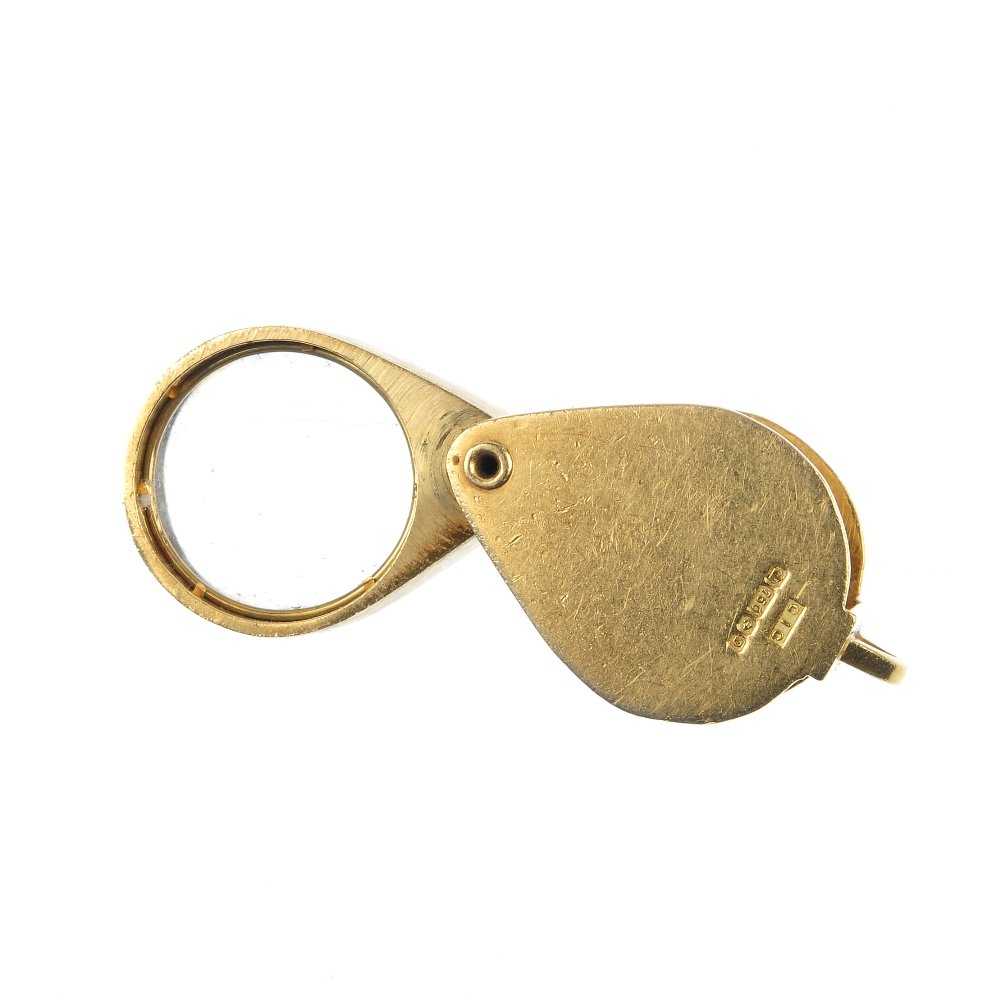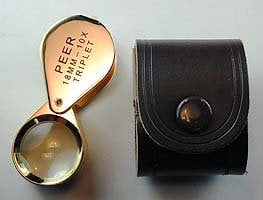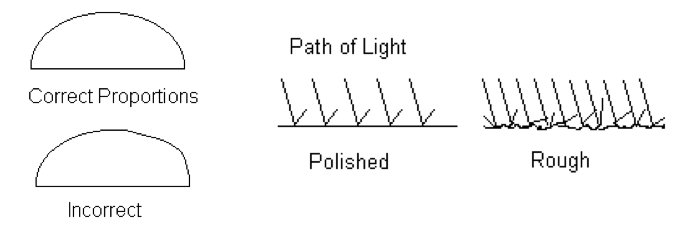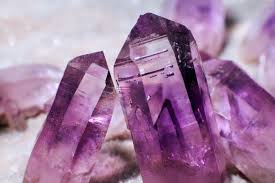Best Type of Magnofier for Reading Jewelry Marks
IGS may receive customer referral fees from the companies listed in this page. Acquire more.
The simple 10X loupe fits in your pocket and costs less than any other piece of gemological equipment. You lot'll learn more with it than any other musical instrument, and it's easier to utilize than most other tools. Y'all can see why many call the hand loupe the gemologist's best friend.

This vintage 10X loupe is made with 18k gold. Luckily, far less expensive models will serve gemologists perfectly. Photograph courtesy of liveauctioneers.com and Fellows.
Tabular array of Contents:
- The 10X Loupe Standard For Evaluating Gems
- How to Utilize a 10X Loupe
- Examining Gem Exteriors with a 10X Loupe
- Surface Observations
- Girdle
- Facets
- Culet
- Examining Cabochons with a 10X Loupe
- Examining Inclusions with a 10X Loupe
- Fractures
- Mineral Inclusions
- Voids
- Healing Fractures
- Other Inclusions
- Evaluating Coloring with a 10X Loupe
- Zoning
- Banding
- Advice For Beginners
- Loupe Recommendations
The 10X Loupe Standard For Evaluating Gems
Loupes come in several varieties. Watchmakers prefer the kind held past the eye socket. Other professionals prefer loupes worn like eyeglasses or clipped onto glasses. Some types sport fancy features like illumination and built-in tweezers. Gemologists prefer the mitt loupe.
For gemologists, the 10X loupe (with ten-power magnification) is the standard for hand-held gem identification. Although you'll find more powerful loupes, the depth of field (the expanse that'southward in focus) is so minor higher up 10X that they're hard to use. Instead, use a microscope when you need higher magnification. With lower-powered magnification, you but can't encounter as much detail.
You may encounter the following terms when shopping for a 10X loupe.
- Triplet: a loupe with three lenses, which reduces distortion effectually the edges.
- Color correction: a special lens coating to ensure you come across natural colors, not colors distorted past passing through the loupe.
These features increase the price.
The standard for judging diamond quality is what an expert can see in good lighting with a triplet, colour-corrected 10X loupe. Gemologists use this same standard for evaluating colored stone quality, as well. However, you don't need to buy such an expensive multifariousness for your gemological studies. You lot tin get as much information and enjoyment from a less expensive model.

Standard triplet 10X loupe
How to Use a 10X Loupe
Using a loupe gracefully takes some practice but soon becomes second nature.
Before you focus on anything, consider the light around you.
- To evaluate cut and polishing, you lot need to see the gem surface. Shine your light down on the stone. This is simple in a room with overhead lighting. If your all-time source is a window, position yourself and then the lite comes over your shoulder. About importantly, avert casting your shadow on the stone.
- To see the inclusions in a gem, y'all need to see the interior. Place your lite backside the stone and shining through it.
With minimal adjustments and a trivial thought, you tin can often see both the surface and interior of a gem. Having too niggling lite to see well is usually the only limitation.
When you open a hand loupe, the cover becomes a handle. To use your loupe, slide your index finger through the opening, button out the loupe, so brace the hand holding the handle against your cheek to steady it. Now, you only have ane hand to motility for focusing.
- Keep both optics open to reduce eye strain.
- Position the gem in front of the loupe.
- Next, move information technology slowly towards and away from the loupe until it comes into focus.
Do adjusting the focus from the top surface to the far side. On a small precious stone, you lot tin go the unabridged rock in focus at once. On a larger jewel, yous'll accept to focus on one area at a time.
Examining Gem Exteriors with a 10X Loupe
To judge the quality of a gem'southward faceting work, yous need to study its surface.
Surface Observations
A smooth, glass-like surface is the sign of a perfect smooth. You may see pits or scratches. However, if they are few and invisible without magnification, they'll take piffling effect on the beauty of the gem.
Sometimes, y'all'll see a stone with small pits covering its entire surface. Although invisible to the naked eye, they exercise affect the gem'southward luminescence. If you compare the rock to non-pitted stones of the same species, you'll see the reduction in brilliance more readily.
Occasionally, you'll have problem distinguishing whether marks are on the surface or inside the gem. To resolve this, rotate the precious stone so the light reflects off the facets. When a facet acts as a mirror, inclusions beneath information technology disappear. Nonetheless, scratches on the surface remain visible.
Girdle
An unpolished girdle reveals the gem cutter was in a hurry. (A custom gem cutter would cease this off). Diamonds are an exception. Gem cutters cut them differently than colored stones because of their extreme hardness. Rounded, unpolished girdles are mutual in diamonds.
Facets
To further evaluate cutting quality, look at the facet meets. On a well-cutting precious stone, they course precipitous corners. All the facets in a row will be the same size and shape. You'll frequently run into facets vary in size and corners that don't encounter or overlap. If the differences are small, they won't affect a jewel's beauty significantly. However, equally the problems increase, the brilliance of the gem suffers.
Examine the sharpness of the facet edges. Due to diamond's hardness, they have the sharpest edges. This clue helps place them. The edges of harder colored stones, such as rubies and sapphires, and cubic zirconia come in a close 2nd. Softer gems (below a 9 in hardness) usually have slightly rounded facet edges. In one case in a while, you'll encounter a custom-cut gem with uncommonly sharp edges in a cloth of only 7 or 8 hardness. Although you may be unable to appreciate all the subtle decisions fabricated cut a jewel similar this, y'all tin can spot expert-quality work by the polish, meets, and facet edges.
Culet
Next, turn the jewel upside down and wait at the culet. Sometimes, gems carried together in paper wrappers suffer chips on the culet. This is chosen paper damage. Over again, if invisible without magnification, this won't impact the jewel's dazzler significantly.
I hope yous see how lapidary quality affects a precious stone. While a minor imperfection or two is acceptable, lots of sloppy piece of work diminishes a gem's beauty, even if the individual instances are invisible to the naked eye. If yous're a novice gemologist, using a 10X loupe gives y'all your outset chance to appreciate this.
Examining Cabochons with a 10X Loupe
Start examining a cabochon by judging the smoothen, just as you would a faceted jewel. Look for any scratches or pits that will reduce the amount of light reflected from the surface.
Side by side, check for contour evenness. A cabochon's surface should accept an even curvature. Expect at the cab from both ends and both sides. The shape, or curvature, should be a mirror epitome from side to side. No area should be thicker than its opposite. There should be no bulging.
At present, hold the gem so calorie-free reflects off its surface. Then, move the precious stone so the low-cal travels beyond the top. On a properly cut surface, you'll see the band of reflected light glide evenly over it. On a surface with irregularities, the ring of light will begin to ophidian. Yous'll almost probable see this on the very meridian of the gem. You may not run into a small, flattened area when viewing from the side but you will every bit light passes over it. Since lite won't flow smoothly over this flattened area, you should consider the cabbing work second-charge per unit. (If you look closely at that area, yous'll likely find poor polishing, too).

Left, correct and incorrect cabochon contour proportions. Right, light won't motility smoothy over an improperly polished surface.
Examining Inclusions with a 10X Loupe
The study of inclusions is i of the almost interesting and useful elements of gemology. When yous examine gems, you'll encounter quite a variety. Gemologists define an inclusion as anything internal that affects the flow of calorie-free. While this sounds negative, you'll too find some beautiful inclusions in natural gems. Every bit you identify them and larn how they formed within the precious stone, y'all may fifty-fifty observe them cipher curt of incredible.
Fractures
You'll find fractures the easiest category of inclusions to identify. Emerald gems virtually always have internal fractures. However, they're uncommon in most other gems. Tiny, internal fractures that don't reach the surface accept minimal outcome on a gem's durability. (Emerging from cutting without damage attests to that). On the other paw, larger fractures or those close to a sparse edge pose risks. Fractures that reach the gem surface can absorb liquids. Over time, they will absorb dirt and pare oils, causing a loss of brilliance.
Emerald vendors may fill these fractures with oil of the same refractive index (RI) as the gem. This treatment makes the fractures less visible and reduces the likelihood they'll blot skin oils. To meet these filled fractures, wait very closely and become the light on them from just the right angle. If y'all see a multicolored radiance, like an oil slick, you've spotted one.
Sometimes, a fracture will stand out, interrupting the flow of lite. Other times, the fracture is pressed together so tightly that light volition period correct through information technology. This type will evidence a bright, multicolored flash when light strikes information technology from the correct angle.
Almost fractures have at least a slight bit of curvature. You must look carefully to see this. If yous encounter a perfectly straight fracture, you've probable found a cleavage fracture. Gems have cleavage planes, much like the grain of wood. Forth the cleavage plane, the gem splits easily. Finding a cleavage fracture in a jewel signals a notable weakness.
Mineral Inclusions
Minerals, whether small $.25 of droppings or whole crystals, are another common type of inclusion. They can be spectacular. Afghan peridot sometimes contains clusters of tourmaline that look like flies. Tiny spinel crystals bundled in a plane sometimes include another spinel.
Some mineral inclusions are opaque, such as black "carbon spots" on diamonds. How much they interfere with the passage of light depends on their size and number. Other inclusions are transparent. Their visibility depends on their RI. If this differs significantly from the surrounding crystal'due south, they volition bound right out at you lot. In other cases, like spinel in spinel, they're nearly invisible. To meet them, you need a dark background behind the gem and low-cal coming from the sides.
Silk is a blueprint of very slender, thread-similar crystals. It'south found in several gems but is especially common in corundum, spinel, and garnet. Y'all'll get the impression you're looking at a gem through a fine layer of silk, if the crystals are fine enough and all arranged in the same direction. The greater the silk saturation, the more than the gem's brilliance will endure. (However, these inclusions also produce asterism in prized star sapphires).
Voids
Yous'll also see many voids or cavities in your gems. Equally crystals grade, they sometimes trap gas bubbles inside. Cavities may as well contain liquids or other crystals. For gemologists, finding two or three fillings in one void is a rare treat and significant clue for gem identification.
Healing Fractures
Sometimes, you might see what looks surprisingly like a fingerprint in a precious stone. That is chosen a healing fracture. At some bespeak in the by, the crystal broke. When the atmospheric condition for growth returned, the crystal healed or grew back together.
Other Inclusions
Fractures, minerals, and voids are the primary types of inclusions you'll ordinarily see. Even so, you'll also find some interesting inclusions in specific gems. For example, peridot may contain lily pad inclusions, small blackness spots surrounded by a curved fracture that wait just similar lily pads. These are common and like shooting fish in a barrel to spot. Rubies and sapphires may bear witness something similar. Sometimes, they contain opaque inclusions with fractures effectually them, though not as beautiful or symmetrical as those in peridot. These indicate the gem has been heat treated. The inclusions flare-up due to heating, creating the fractures.
Evaluating Coloring with a 10X Loupe
Color in gems may not e'er be distributed evenly. For case, lapidaries cut stones such as ametrine and watermelon tourmaline to show off the separate colors. In most gems, however, you need to look carefully to see them.
Zoning
Amethyst may show color zoning, areas of night purple surrounded by lighter imperial or fifty-fifty colorless quartz. Past careful cutting and orienting the color in the culet, you tin can make the gem evenly colored when face. This will bring the about eye appeal to the gem. The value of the gem decreases if you can run across the zoning face upwardly or with slight tipping.

Amethyst Color Zoning
Sapphires also commonly testify zoning. Once more, if you can't see the zoning face, it doesn't touch the value of the gem.
Banding
While the colour zones in an amethyst are random, the zoning in a sapphire occurs in straight bands. They're present fifty-fifty if they're not distinct plenty to be seen with the naked eye. To see them all-time, view the gem with a 10X loupe from the lesser with light coming from behind information technology.
Y'all have to look direct on to the plane of colour to distinguish the banding. Due to the cutting, you lot'll simply see the banding in i facet at a time. To see this takes a scrap of practice, just information technology's worth learning.
Once you see the banding, bank check if information technology'south straight or curved. Whatever curvature you see will be subtle but significant, so look advisedly. If the banding or striae is curved, the sapphire is a flame-fusion constructed. (Still, straight banding tin can be due to natural or synthetic origin).

Banding Curvature in a Synthetic Sapphire
Communication For Beginners
You lot can get a lot of information from your 10X loupe. If you're a beginner, you'll probably take dozens of questions after trying out the manus loupe. Permit those questions straight you to your next level of study.
Just think ii things: exercise makes perfect and have your time. Gather as much data as yous tin from your loupe inspections.
Loupe Recommendations
| Photo | Proper name | Meridian Reviews on Amazon |
|---|---|---|
 | JARLINK 30X 60X Illuminated Jewelers Eye Loupe Magnifier | "Dearest the LED light. Bright enough to show crystal shapes and sizes on even a dark rock. Bought it to show students rocks and minerals upwards close. I love the two magnification choices. Students are amazed when they look at the rocks up shut." read more |
 | Fancii LED Illuminated 20X Jewelers Loupe Magnifier, Triplet Drinking glass | "This loupe is very good for seeing things very close up. I was using a 5X magnifier loupe and it wasn't enough when looking at some watches and watch parts. Very overnice inclusion of the light. Very fine item I am now able to meet with ease. Very fun and useful." read more |
 | BelOMO 10x Triplet. Jewelers Loupe Magnifier 21mm | "The Hastings Triplet, designed by the 19th century genius optical engineer Charles Hastings, when properly executed, results in a magnifier with nearly-perfect clarity almost from border-to-edge. The usable surface area is upwards of 100% of the lens area. The Hastings design too results in well-nigh perfect colors." read more |
Equally an Amazon Associate, nosotros earn from qualifying purchases referred from our site.
Source: https://www.gemsociety.org/article/10x-loupe-the-gemologists-best-friend/
0 Response to "Best Type of Magnofier for Reading Jewelry Marks"
Enregistrer un commentaire